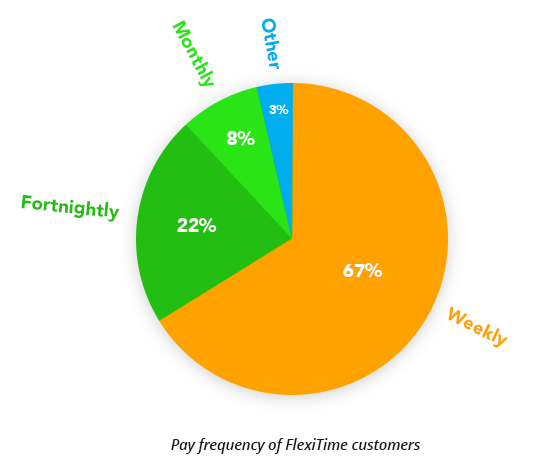Payroll & Finance
How often should you pay your employees?
July 28, 2016
So, you’re about to hire your first employee. Exciting times. One of the first payroll questions you’ll need to answer is, “How often should I pay my staff?”
The short answer is that there is no right answer. There is no legally required pay frequency in New Zealand, so you need to weigh up the pros and cons of the various options and decide what’s best for your business and your employees.
If you’re wondering how others do it, around two thirds of FlexiTime customers pay their staff weekly. Another 22% pay fortnightly and most of the remainder pay monthly.
We see a few variable, four weekly, three weekly and daily pays, but they are pretty unusual.

When choosing your payroll frequency, there are four things to consider; your employees’ preference, time spent running payroll, the cost involved and any accounting implications.
Generally speaking, employees prefer getting paid more frequently. However, more frequent pay runs can mean more administrative work and may cost more (though that’s not always the case!).
So, let’s take a closer look at your options.
Weekly Pays
Weekly pays are by far the most common approach in New Zealand. Especially in industries where employees get paid by the hour and work variable hours, including hospitality, retail, manufacturing and trades.
Pros
Employees who earn an hourly wage, in particular, prefer weekly pay periods. Weekly pays mean a regular, predictable cash injection into their bank account, which makes it easier to keep on top of bills and expenses.
If an hourly employee has an irregular working pattern, weekly payroll is the best alignment of work and earnings. If they’ve worked additional hours or overtime, they get paid for that effort in the first week when they might need it most.
Paying staff weekly and balancing the books more regularly also allows you to more closely align the benefit derived from the labour with the cost of the wages. Where there are regular staff queries about hours and rates it can be advantageous running the pay as close to when the work happened – it’s hard to remember what happened 4 or even 2 weeks ago (I struggle to remember what happened yesterday!).
Cons
The more often your company runs payroll, the more time the business owner or payroll manager will need to spend running pays. However, if you’ve got the right payroll system and the right setup, running a pay should only take a few minutes.
Outsourced payroll providers and many online payroll systems charge you each time payroll is run, in which case there is an extra cost associated with weekly pays.
There are also some calendar-based quirks that can add complexity. With weekly pays there are normally four pay runs per calendar month, but some months have five. This can complicate any budget or costing estimate that is done on a monthly basis.
Salaried employees paid on a weekly basis will receive one extra pay every six or seven years. This is because weekly salary amounts are calculated by dividing the annual salary by 52. But, there are actually 52 weeks and 1 day in a year (2 extra days in a leap year) and these add up so that once in a while there will be 53 pays in a year instead. We recommend not trying to adjust for this or you might find yourself having some very complex arguments (see the dispute mentioned under fortnightly pays below).
Fortnightly Pays
Fortnightly is the second most common pay cycle in NZ. Employees are paid on the same day every second week and there are usually 26 pay days in a calendar year. This is the pay frequency that most government agencies use.
Pros
The benefits of fortnightly pays are similar to weekly pays. It would be the second preference for most employees. Obviously there are half the number of pays to process for payroll staff. It’s also nice and easy to calculate overtime for hourly employees because the number of working hours in each pay period never changes.
Cons
From an accounting perspective, fortnightly pay schedules can complicate matters. They don’t coincide with calendar months and can add complexity to monthly budgets and costing analysis.
Two months out of the year will have three pay periods instead of two and occasionally there will be 27 pay periods in a calendar year (as opposed to the normal 26).
This means it can be harder to budget (especially for smaller companies or startups), and the amount you spend on your labour costs will fluctuate each month. Your accountant or bookkeeper may have to make payroll expense accruals so costs are recognised in the month the compensation was earned.
Those years with 27 pay periods can be quite problematic. There is a dispute about fortnightly pays for teaching staff currently under negotiation. The arguments here can do your head in. It’s best to just accept that over time you’re paying your staff for, on average, an extra one and a bit days a year.
Monthly Pays
Despite being very common overseas, particularly in the UK, monthly pay cycles are rarer in New Zealand. This pay cycle is most commonly used by larger businesses that employ salaried workers only.
Pros
Paying once a month, or 12 times a year, requires the least amount of effort from the employer and is also the least costly.
Monthly pay cycles work well if you want to keep the cash outflow on a consistent day of the month. If you receive a lot of revenue on the 20th of the month for example, then it may make sense from a cashflow point of view to do monthly pays soon after that date.
From an accounting point of view, pay periods coincide with monthly reporting, meaning there’s no need for accruals and ensuring a consistent outlay of payroll expenses from month to month.
Cons
Monthly pays are generally the least favoured option for employees. It’s harder for them to budget and in some months they need to make their money stretch for more days than others.
Monthly pay cycles make it very difficult to use Time Bank to accrue paid time off for salaried employees who work in excess of their regular hours.
For an employee working 40 hours a week and earning a salary, it’s easy to keep a record of the hours they work above and beyond 40 hours for a weekly pay cycle or 80 hours for a fortnightly pay cycle.
However, when paid monthly, an employee’s salary is calculated based on 173.33 hours per month (or about 21.6 eight-hour days). Because months vary in length, the actual number of hours and days worked in a month will change. That makes it very difficult to keep an accurate record of the number of hours worked above or below the contracted hours.






